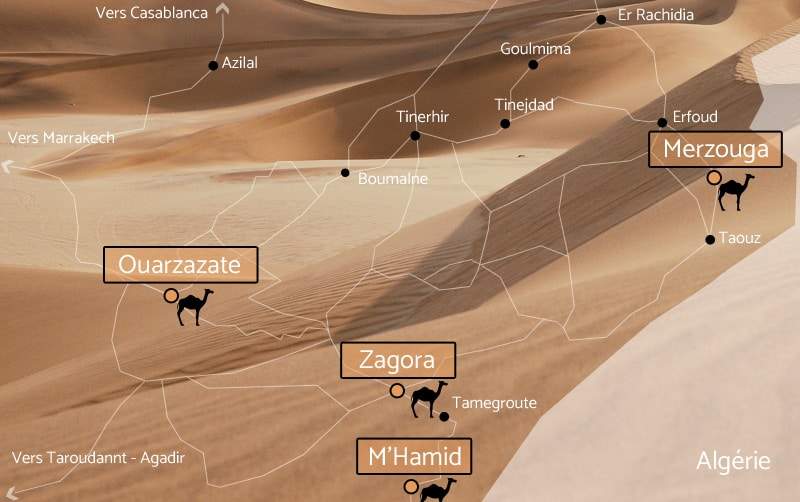
Blog
The Sahrawi nomads of Morocco
Let’s travel through culture, here is what we offer you in this article on the nomads of the Moroccan desert, this mysterious people who continue to inhabit the Sahara today. Sahrawi nomads of Morocco are Bedouins, therefore Arab nomads who for some have settled down. The “Tuaregs” are also the inhabitants of the Sahara. This designation is used for the inhabitants of the desert in Mali, Niger, Sudan. The Tuaregs (Mali) were originally called the “Tamasheq” people, “the veiled people” or “the free men”. Tuaregs and the Sahrawi nomads are also called “blue men” in reference to their indigo-colored clothing.
Sahrawi nomads in Morocco, who they are?
The Sahara is the largest hot desert given its extent. The Sahara is located on the territory of 10 states on the African continent: Morocco, Algeria, Tunisia, Libya, Egypt, Mauritania, Mali, Chad, Sudan, Niger. The Tuareg and nomadic population in the Sahara is estimated at around 4 million people.
In Morocco, the Sahrawi nomads once controlled the caravan trade between Morocco and Niger. In recent decades, more and more nomads have settled in oases, where they do some agricultural work. These nomads are installed on the edge of the desert (for example as in the village of M’hamid El Ghizlane).
The nomads or “inhabitants of the desert” of Morocco, like the Tuaregs, are above all breeders of camels, goats, sheep. Those among the Sahrawis who lead a nomadic life leave in the desert during the winter and return to the edge of the desert during the summer which can be very hot. They constantly move in search of pasture and live in traditional black tents woven with goat wool and camel hair. Conditions can seem austere in the desert: hot and dry climate during the day and cold at night.
Where do the Sahrawi nomads live?
In Morocco, the Sahrawi nomads live in the South of the country.
M’hamid El Ghizlane, Tata, Guelmim, Tan-Tan, Laâyoune, Western Sahara … you can meet Sahrawi nomads in southern Morocco, in the desert.
Language and culture
In Morocco, the Sahrawi nomads speak hassanya. This dialect also called “hassani” is spoken in southern Morocco, in Western Sahara, in Mauritania, in the north of Mali, in a part of Senegal. The culture of Sahrawi nomads is characterized by solidarity, family spirit and hospitality. Nomads lead a life in simplicity.
The nomads like to get together and to have tea together. Preparing and serving tea is a very special ritual for nomads. Tea is served and drunk regularly throughout the day.
In the evening, around the fire, while waiting for the meal to cook on the embers, they are singing and playing with different musical instruments. All the men gathered participate.
Sahrawi women
Sahrawi women weave wool and take care of the house and children. They often get together to spend time together drinking traditional tea. Sahrawi women wear “Malhfa”, a colorful traditional dress with different patterns. The Malhfa is a long fabric with which nomadic women can skillfully make a coat that covers them from head to toe. This dress also allows women to keep half of their face covered. Sahrawi women use kohl for the eyes and henna applied to the hands.
Men, meanwhile, wear the traditional gandoura and a turban.
The traditional turban allows them to protect themselves from the sun and the sand.
Jewels of Sahrawi nomads
- Southern crosses
The southern cross, or the cross of Agadez or Iferwan, is the symbol of virility and traditional nomadism. It was once worn exclusively by men and passed from father to son at puberty. There are different southern crosses, each associated with a nomadic village or tribe. The cross represents the pommel of the camel saddle or the four cardinal directions.
Transmission of the jewel : the father evokes to his son the eternal sentence “My son, I give you the four directions of the world, because we do not know where you will die“.
- Talismans
The Sahrawi nomads believe in the talismans that protect them. Often, men wear rings or bracelets as talismans.
The Sahrawi nomads, their culture and traditions, their way of life, their adaptation to the arid conditions of the desert, will again and again captivate the minds of thousands of curious and adventurous people, thirsty for exoticism and mystery.
Contact
Message
Feel free to contact us for any question about your next Morocco desert tour or Morocco travel. We will be happy to get back to you as soon as possible.

Our company is located in M’hamid El Ghizlane, South Morocco, Zagora province. ICE 003002027000023
By sending a message via the contact form, you agree that your personal data collected is processed to manage your request. You can withdraw your consent at any time. To know more about your rights, consult the Personal Data Protection Policy and the Cookies Policy.